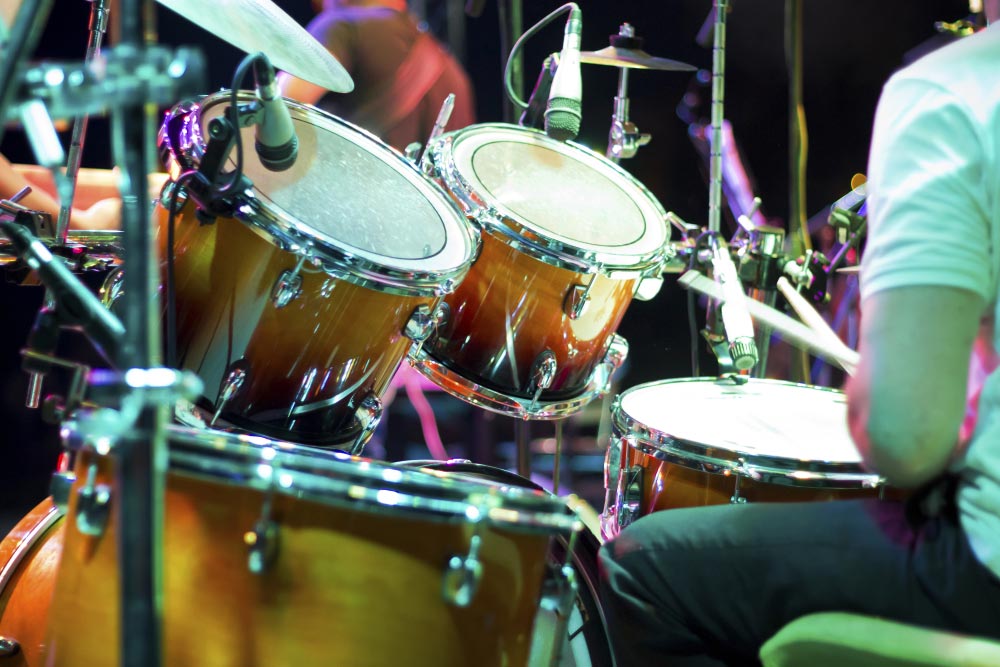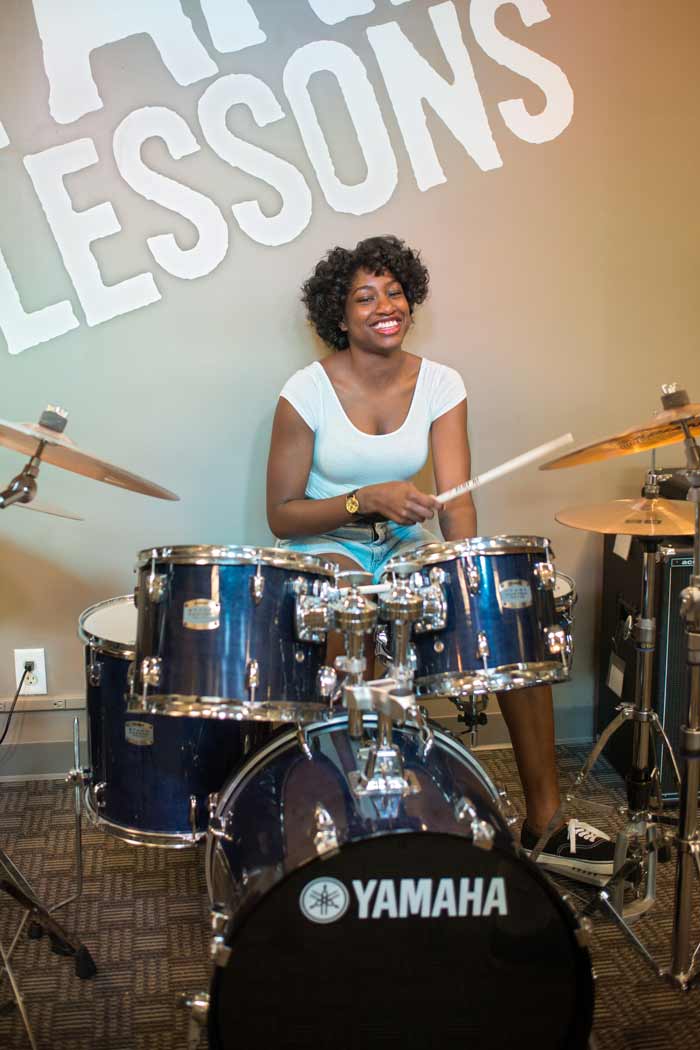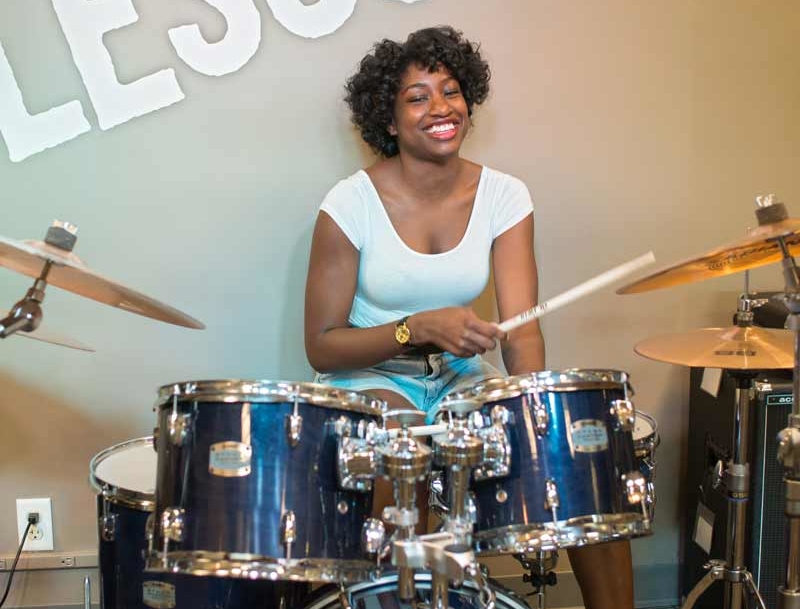May 04, 2015
Drum Kit Buyers Guide


The Right Drums, Cymbals and Hardware for Your Kit
As the old saying goes, a band is only as good as its drummer. Sure, they might not always be out front and in the spotlight like a vocalist or lead guitarist, but drummers are essential to keeping the rest of a group in sync and on time. And whether your style is heavy metal, jazz, funk, country, or rock, you’ll have no problem finding the right percussion gear, accessories, and learning resources after reading this drum kit buyers guide.
Note: If you run into any unfamiliar terms along the way, don’t panic! A glossary has been included at the bottom of this guide.
Different Parts of a Drum Set
These days there are a wide range of drum sets to choose from, but finding the right one for you is easier than you think. First off, let’s take a look at the different components that make up a kit, which include: the snare drum, the bass drum, one or more mounted toms, and the floor tom. Cymbals and hardware are also important, but we’ll get into those later.
For beginners (or if you’re an amateur who simply likes to jam with friends), a 4-piece kit that contains a snare, bass drum, single mounted tom, and a floor tom will give you all the basic sounds you need. In fact, many rock drummers became famous for this simple configuration, including legends like Ringo Starr and Charlie Watts. Smaller kits are ideal for genres like jazz, blues and rock; they’re easy to transport, and they also take up way less space than larger kits.
Choosing your Drum Set
If something larger is what you’d prefer, there are plenty of five-piece and six-piece kits out there as well. These drum sets add extra toms to expand on your sound, and are excellent for styles like fusion, contemporary, and metal.
Most drum sets are available in two configuration types: standard and fusion. The diameters of each drum in the kit will tell you its configuration. For example, standard-sized sets normally feature a 22” bass drum, 12” and 13” mounted toms and a 16” floor tom. On the other hand, fusion sets usually consist of a 22” bass drum, 10” and 12” mounted toms and a 14” floor tom. Fusion sets are known for their articulate sound and punchy tone due to their smaller diameters, while standard-size sets boast more volume thanks to their larger toms.
Here are some other popular configurations:
Double bass drum set: You’ve probably caught a glimpse of these sets in many legendary rock photos. Originating with jazz percussionists and made popular by many rock drummers in the late ’60s and ’70s, double bass drum sets are great for those who want to play powerful beats at lightning-fast speeds.


Complete drum set: These have all the hardware you need, but if you already own the hardware, you might want to look into buying a Shell Pack, which will feature just the drums with no additional hardware besides the rims and tom mounts. Or, if you want to expand on a drum set that you already own, there are many add-on packs to choose from as well, and they often cost less than purchasing the add-on drums one at a time.
Starter drum set: If you’re in the market for a beginner-friendly option, a starter drum set is perfect. Not only are these kits very affordable, but they contain all the drums, cymbals, stands and hardware an aspiring player needs to start their percussion journey on the right foot.
Junior drum set: For younger children, a junior drum set is a cost-effective solution to nurture their percussion talents. These kits are scaled down in size to suit kids, yet they’re also solidly built to feel and sound like a regular set.


Popular Woods for Drums
The type of wood that’s used in a drum’s construction will play an important factor in how it sounds. Many different types of wood are used depending on the drum manufacturer, and each kind offers its own distinct qualities:
Maple: Known for its warm and balanced tone, maple is the most popular type used for drum making.
Falkata: This wood is very similar in sound to maple, and because it costs less, many drum companies use it as a maple substitute.
Birch: Compared to maple, birch is much brighter and tougher. It’s also quite loud, making it ideal for recording due to its ability to cut clearly through a mix.
Mahogany: Favored by players who like an enhanced low end and mid-range, mahogany has a warm sound that’s often described as “vintage” in character.
Poplar: With a sound that resembles birch, poplar is also very affordable.
Basswood: Less expensive than maple and birch, basswood has a striking visual appearance that blends well with lacquer finishes.
Lauan: Sometimes called “select hardwood”, lauan wood is often used as a cost-effective alternative to birch.
Oak: With a sound similar to maple, oak is quite rare, but when it is used, it makes for a very powerful and bright drum tone.
Drum Construction
Drum shells consist of several plies, or layers, of wood. Generally, more plies make for a brighter sound and higher fundamental note. On the other hand, drums with fewer plies are typically warmer with a lower fundamental note.
The sound quality of a drum is also heavily influenced by the angle of a drum shell’s bearing edge. A rounded bearing edge produces a mellower tone, while a sharper edge delivers a brighter tone.
Drums also come in many different finishes. Covered finishes, for example, are affordable treatments that use vinyl wraps, which come in a variety of looks and patterns. Compared to natural finishes, covered finishes are more scratch-resistant and provide better durability. Transparent lacquer finishes are also quite common, and are known for their ability to enhance the woodgrain for a natural appearance.
Drum Hardware
Even if you owned every drum in the world, you can’t call it a drum set until you bring it all together with the necessary hardware. Important pieces include snare and hi-hat stands, one or more cymbal stands and a bass drum pedal. Of course, unless you’re purchasing a shell pack, most complete drum sets come with the hardware you need, although what each set contains may vary.
To save money, you might want to consider looking into a hardware pack. Typically, these bundle options feature stands, pedals and thrones, and will cost you less than buying them all separately.
Drum Thrones & Drum Pedals
When you’re sitting behind the kit doing what you do best, you want to feel relaxed through every whack and thwack you make. For this reason, you’ll want to choose your drum throne wisely, since they usually aren’t included with drum sets. Thankfully, Music & Arts offers an impressive variety of thrones, each of which are compact, easily adjustable, and padded to ensure a comfortable playing experience.
This Gibraltar 6600 Series lightweight compact seat delivers premium performance and comfort at a great low price. Drummer’s throne adjusts from 18″ to 24″ high. Learn More.
From simple single-pedal models to the double pedals often preferred by metal and fusion drummers, today’s selection of bass drum pedals is far-reaching. There are double pedals with single beaters for dual bass drum sets, double beaters for single bass drums, and many other configurations to choose from.
This DWCP3000 Single Kick Drum Pedal is packed with features like dual-chain Turbo drive, bearing spring rocker assembly, 101 2-way beater, and heavy-duty all metal construction, with a price tag that’s in reach for more drummers. Learn More.
Stands and Racks
In this day and age, your drum and cymbal stand choices are seemingly endless. With that in mind, the best drum, percussion, or cymbal stands for you will depend on the configuration of your kit, as well as your budget.
If you’re looking for an alternative to mounting your cymbals and drums on stands, you might prefer a drum rack. These frame-like structures are a convenient and portable way to hold multiple cymbals and toms. Just check out the variety of racks and rack accessories we have in stock here at Music & Arts to see how versatile they really are
Cymbals
No drum set is complete without cymbals, and since most kits don’t come with them, you’ll want to choose yours based on what best suits the music you’re playing. The most common cymbal types are the crash, ride, and hi-hat… although the popularity of China and splash cymbals has also increased in the past few decades. You can also check out effects cymbals for a fun way to incorporate different colors and sounds throughout your performance.
The Zildjian A Custom splash delivers a fast, colorful, short crash sound. Learn More.
Cast cymbals: This kind of cymbal is created by pouring molten metals, which then go through a long process of being heated, rolled, shaped, hammered and lathed. The result is a unique cymbal that’s very full and complex, and only gets better with age.
Sheet cymbals: More affordable than case cymbals, sheet cymbals are cut and hammered from metal sheets, and tend to have a very consistent sound from cymbal to cymbal within the same model.
Choosing the Right Cymbals for You
Beginner kits tend to come with stock cymbals, giving you the tools you need to get started. But most kits and shell packs do not come with cymbals. So how do you weed through the plethora of options out there? Where should you start? The truth is, it’s all brand preference and budget.
For beginner to intermediate, the best way to get your first set of upgraded cymbals is via a cymbal pack. These typically come with a hi-hat pair, a crash cymbal, and a ride – giving you the main cymbals you’ll use for most music. Prices vary depending on which cymbals you’re getting and the quality of those cymbals – just make sure the pack has the cymbals you’re looking for before getting it!
This Zildjian ZBT 3 Cymbal Pack includes an 18″ crash ride and a pair of 13″ hi-hats plus a free 14″ crash. Learn More.
For the more advanced drummer, you probably have your core cymbals already, and now you’re looking for new china or splash cymbals to take your sound to the next level. At this point you’re buying a la carte, and you already have brand preferences. Don’t forget to grab the extra hardware you need.
The Meinl HCS China Cymbal projects an explosive, brash and bright attack with deep, dark and trashy undertones. Learn More.
Snare Drums
With its crisp, snappy sound that cuts through every other drum in the kit, the snare drum is essential to keeping the beat moving, and also for adding accents. The snare’s unmistakable tone comes from its wires (or snares) that are held against the drum’s thin bottom head by a device known as a strainer, which is mounted on the shell.
The Vintage Series 6″ x 14″ 4-ply maple shell with 6-ply reinforcing rings is modeled after some of the most popular vintage snare drums. Learn More.
Traditionally, snares are made of wood or metal. Wood snares produce a warm, mellow sound, while metal snares have a bright and cutting tone. Usually, snares are 14” in diameter and range in depth from 3-1/2” to 8”, although there are many specialty snare sizes available as well.
As you become a more experienced player, you may be interested in owning additional specialty snares. Some common types are the piccolo, soprano, sopranino and popcorn snare, all of which are smaller and higher in pitch than regular-sized snare drums. Many drummers who play electronica styles like drum ‘n’ bass, jungle and trance prefer the high-pitched tone of these specialty snare drums.
The aged 6-ply maple shell produces incredibly warm tone and a brilliant attack and offers peerless tuning latitude. Learn More.
Drum Heads
The types of drum heads you play on will greatly impact the sound of each drum in your kit. Drum heads come in clear, coated, single ply, and double ply. Batter heads are used for the top of your drum (the side you’ll strike), and resonant heads are placed on the bottom to make your sound ring out longer (better known as sustain).


These days, most drum heads are made of a thin plastic called Mylar, and many styles and colors are available, with or without a spray-on coating. Coated drum heads, preferred by many jazz percussionists, have a warm sound with less ring and projection, and are often used in recording studios.
Evans G2 Coated Batter Drumheads are durable 2-ply tom heads with a coating for added warmth, focus, and depth. These heads make small toms sing and floor toms growl. Learn More.
In terms of thickness, drum heads come in single and double plies. The thicker of the two (double ply) has a quicker decay and more focused attack. Naturally, double-ply heads are also more durable, and they sometimes come with material sandwiched between the two plies to dampen the tone.
While most rock drummers enjoy the boisterous sound of two-ply heads, jazz players often favor the quick response and sound of thinner, single-ply heads. With all of this in mind, your best bet is to try out both and see what type you like the most.
For snares, two types of heads can be used. On the bottom, a very thin head is placed for sensitive response to the metal wires that are held across it. On the top, a coated head is what most drummers use, since they’re good at controlling the snare’s lively response.
There are several ways that you can dampen excessive ringing and sustain in your drums. Some methods include using a felt strip on the bass drum’s batter head, cutting a hole in the front bass drum head, or putting a pillow against the inside of a batter head. Drum sound-dampening rings, patches and pads are also available to reduce ringing, many of which are designed for the ability to tailor the dampening effect to your own liking.
RTOM Moongel Dampening Gels effectively control unwanted drum overtones. Designed to be versatile tone modifiers, self-adhesive Moongels stick to the surface of your drums, cymbals, and most percussion instruments. Learn More.
Electronic Drums
Thanks to technology’s many breakthroughs, electronic drum kits have never sounded so realistic, and they also offer many unique advantages. For one, they give you a headphone option for practicing in silence, which is ideal if you’re a parent of young children or live in a quiet neighborhood and prefer to hone your skills late at night. Plus, if you’re laying down beats in the studio, you can plug your electronic drum module directly into the mixing board.
The Simmons SD500KIT full-sized 5-piece electronic drum kit includes 4 drum pads, 3 cymbal pads, hi-hat controller and an integrated kick pad/pedal, creating an ultra-realistic drum configuration. Learn More.
Electronic drum sets are loaded with hundreds of drum and percussion sounds as well. By playing the rubber or mesh pads, you can trigger many cool effects within a digital drum module. This can also be achieved with the use of drum triggers, which are small sensors that attach to your drum heads and allow you to play sounds from an external electronic drum module.
Note: Unless you’re using headphones, electronic drum sets need to be connected to a sound system in order to be heard. An electronic drum kit monitor speaker and amplifier will also be required if you plan on performing with a group.
The Simmons DA50 is a 50-watt workhorse that’s the ideal drum monitor for practice, rehearsal, and even small clubs. Its 1/8″ MP3 input and 1/4 aux input with independent volume control allows you to mix in prerecorded backing tracks. Headphone jack for silent practice. Learn More.
Sticks and Brushes
Drum sticks come in so many different sizes and shapes, and the right sticks for you will depend on what you feel most comfortable with and what type of music you play. For example, if the music you’re drumming to requires more volume, you’ll want to go with a heavier stick like a 2B. On the other hand, lighter sticks, such as 7As, are better for styles like folk and jazz.


When searching for sticks, you’ll notice that each pair has an assigned number and letter (5A, 5B, 2B, 3S, and 7A). The number represents the stick’s circumference: the lower the number, the larger the stick (and vice-versa).
As for the letters, “S” stands for “street”, since they were originally designed for street applications like marching bands, and “B” sticks were meant for “band” applications like symphonies and brass ensembles. “A” sticks are actually orchestral drum sticks, and they’re quite popular with jazz and rock players.
Stick tips are available in your choice of nylon or wood. Nylon tips are durable and produce a focused cymbal sound, while wood tips are known for delivering a warmer, softer sound.
These Zildjian drumsticks are a consistent favorite for its medium sized dimensions and teardrop bead. Learn More.
For drummers who play ballads and quieter jazz stylings, you’ll definitely want a set of brushes. Like sticks, brushes come in many different shapes, sizes, and materials including metal bristles, plastic bristles, loops, and ball ends. As for brush handles, they’re usually made of wood, rubber or aluminum.
Steve Gadd and Vic Firth have solved the age-old problem of wire brushes snagging on new coated drumheads. Learn More.
Bundled sticks (sometimes called “rods”) are also an option. Consisting of dowels bundled together, these sticks have a sound that’s sort of half way between brushes and sticks, making them a top-notch choice for playing at lower volumes.
Use Pro-Mark Hot Rod drumsticks to create fresh new dimensions of sound. Hot Rod sticks are a Pro-Mark original handmade in the USA of select birch dowels. Learn More
Practice Tools and Accessories
Maintaining the quality of your drum set is easier than ever thanks to the wide range of products that are now available to make your percussion experience a more enjoyable one. As you’ve probably guessed, there are thousands of drum accessories out there like care and cleaning kits, drum keys and tuning tools, cases, gig bags and covers, replacement parts and much more.
Of course, like any musical instrument, practice really does make perfect, and for this reason, every drummer should own a practice pad. Not only can today’s pads and drum mutes mimic the exact feel of regular drums and cymbals, but your neighbors will also appreciate you for keeping the noise to a minimum.
One side has soft rubber for quiet practice while the other has hard rubber for intensifying the workout and hearing each stroke. Learn More.
Learning Tools
There are all kinds of learning tools available to teach you the beats and techniques that every drummer should know. From courses and lesson books to interactive CDs, DVDs and even drum instruction tutorials from some of the best percussionists in the world today there are certainly more than enough options to choose from.
Alfred’s Ultimate Play-Along series gives you everything you need to jam with your favorite songs. Learn More.
The best option for any drummer trying to get better is private instruction. You’d truly be amazed at how quickly you can progress with the individual attention you get in a private lesson environment.
Click here to learn more about Private Lessons near you!
Conclusion – The Beat Goes On
Now that you have an idea of what to look for when purchasing a new drum set, by all means dive in and explore Music & Arts‘ choices. Remember, it’s always in your best interest to find a kit that matches your own musical tastes. Think about who your favorite drummers are, and take those influences into consideration: doing so will help you make a quicker decision in finding something that you can be happy with. In other words, walk to the beat of your own drum, and have fun!
Still have questions? Our Experts are standing by to help answer your questions! Call 1-888-731-5396























